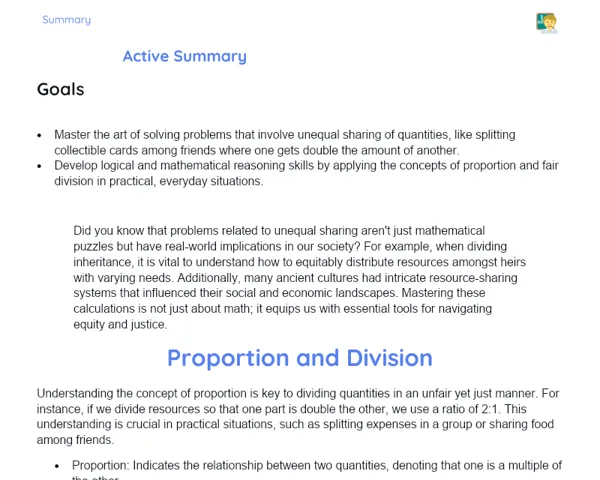Goals
1. Understand the formula for finding the area of a trapezoid, S = h(B + b) / 2.
2. Learn to apply the formula in calculating the area of various trapezoids in everyday problems.
3. Enhance your mathematical problem-solving skills.
4. Encourage critical thinking and analytical reasoning when dealing with real-life situations.
Contextualization
Trapezoids are shapes we come across regularly, whether it’s in the design of land plots, house roofs, or even some bridge structures. Knowing how to calculate the area of a trapezoid is very useful in fields like civil engineering, architecture, and surveying – where estimating the area of uneven surfaces is common. For example, a civil engineer may use this formula to calculate the amount of material required for road construction, while an architect might apply it when designing a roof with a trapezoidal shape.
Subject Relevance
To Remember!
Definition of a Trapezoid
A trapezoid is a four-sided figure that has two parallel sides, known as bases, while the other two sides are non-parallel. This property sets it apart from other figures like rectangles and squares.
-
A trapezoid has two parallel bases: the longer base (B) and the shorter base (b).
-
The non-parallel sides are often called the legs or oblique sides.
-
The height (h) is the perpendicular distance between the two bases.
Trapezoid Area Formula
The formula for calculating the area of a trapezoid is S = h(B + b) / 2, where S represents the area, h is the height, B is the longer base, and b is the shorter base. This equation can be thought of as summing the areas of two triangles that make up the trapezoid.
-
To find the area, add the two bases, multiply by the height, and then divide by 2.
-
This formula is key to solving practical problems that involve measuring trapezoidal surfaces.
-
Familiarity with this formula is invaluable in many professional fields.
Practical Application of the Formula
The area formula for a trapezoid is widely used in practical situations like civil construction, land surveying, and architectural design. For instance, it can help determine the quantity of materials needed to cover a trapezoidal surface or to measure the area of an irregular plot of land.
-
Civil engineers use the formula to compute areas for projects such as bridge or road construction.
-
Surveyors apply it to accurately measure areas of land parcels.
-
Architects use the formula when designing structures like trapezoidal roofs.
Practical Applications
-
Civil engineers calculate the amount of asphalt needed for covering a trapezoidal roadway.
-
Surveyors measure the area of a trapezoidal plot for accurate division of property.
-
Architects design trapezoidal roofs and determine the number of tiles required.
Key Terms
-
Trapezoid: A four-sided figure with two parallel bases.
-
Longer base (B): The larger of the two parallel sides in the trapezoid.
-
Shorter base (b): The smaller of the two parallel sides in the trapezoid.
-
Height (h): The perpendicular distance between the two bases.
-
Area (S): The measurement of the trapezoid's surface, computed as S = h(B + b) / 2.
Questions for Reflections
-
How might inaccuracies in calculating the area of a trapezoid affect the amount of material required in a construction project?
-
In what other areas of study could the understanding of trapezoid geometry be put to good use?
-
How can solving practical math problems like this improve your day-to-day problem-solving skills and future career prospects?
Drawing and Calculating Trapezoids
In this mini-challenge, you are required to draw several trapezoids, measure their dimensions, and compute their areas using the learnt formula. This exercise is designed to reinforce your understanding of the concept.
Instructions
-
Draw three different trapezoids on a sheet of paper, each with different measurements for the bases (B and b) and the height (h).
-
Use a ruler to accurately measure the bases and height of each trapezoid.
-
Apply the area formula (S = h(B + b) / 2) to calculate the area of each trapezoid.
-
Record the measurements along with your calculations next to each drawing.
-
Compare your results and reflect on the precision of your calculations.



